Cancer: when cells go rogue
As a major health factor, cancer kills and makes people’s lives miserable all over the world. Check this out if you want a deeper dive into the mechanisms and causes of cancer.
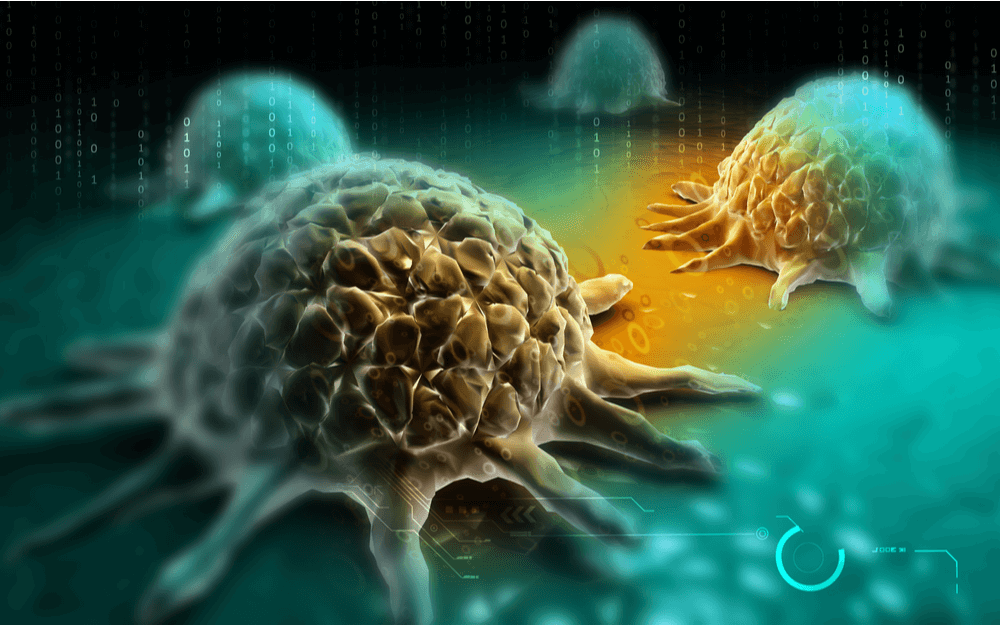
When we talk about cancer, we talk about what’s going on with cells inside the body.
Cancer is a complex thing, but generally, it comes down to what doctors call abnormal cell growth—that is, a single cell dividing endlessly and growing out of control. We will start by describing cancer cells and then continue by learning what sets the mechanism in action.
This unstoppable growth is the main danger of cancer. The tumors spread through the body and grow into critical organs, making them unable to function. Ultimately, one of the affected organs fails, and that’s how cancer kills. The only way to treat cancer is to remove it from the body in some way.
We still don’t know every possible cause of cancer, and sometimes we can only make a guess. Still, science has progressed a lot in learning new methods to treat this disease and offer some advice on minimizing the risk. We’ll talk about some of that here too.
Nearly 4 million people die from cancer each year. Compared to 1995, the figure is more than 20% higher. So, it must be that our problem with cancer has got worse, right? How can it be—if medicine surely has got better? It depends on how we look at the statistics. You’re more likely to get cancer as you grow older. There are more humans on Earth, and they live longer (thanks to advances in medicine)—that means more people die from cancer and not from other things.
Where the cancer hits the most
Lung cancer is the deadliest, though the highest number of registered cases is related to stomach cancer. Is there anything special about those organs that they get affected the most?
What is the mechanism that transforms a healthy and productive cell into an anomaly set out to kill you?
One tissue in our body is more susceptible to cancer than others. In other words, there is a particular kind of cell that is more likely to develop a tumor.
Breasts, bowels, stomach, skin, and lungs are covered and lined with epithelium. Tumors in these organs make up 90% of cancer cases. Cancers in non-epithelial cells—blood cells, connective tissue, and bones—make up the remaining 10%.
So, is there anything special about the epithelial cells? In fact, yes—they divide much more often than others. An epithelial cell can go through up to 3000 divisions and more through a lifetime—approximately one division every week!

If you wonder why the epithelial tissue needs to renew so often, consider its functions. It protects you, actively interacting with the environment and the surrounding tissues.
What makes a cancer cell
Let’s take a look at the process of cell division to get an idea of why it can sometimes go wrong.
Cells divide to replace the damaged ones. First, a healthy cell copies all of its chromosomes—this process is called DNA replication. The entire cell then divides into two, creating identical copies of all of its internal components.
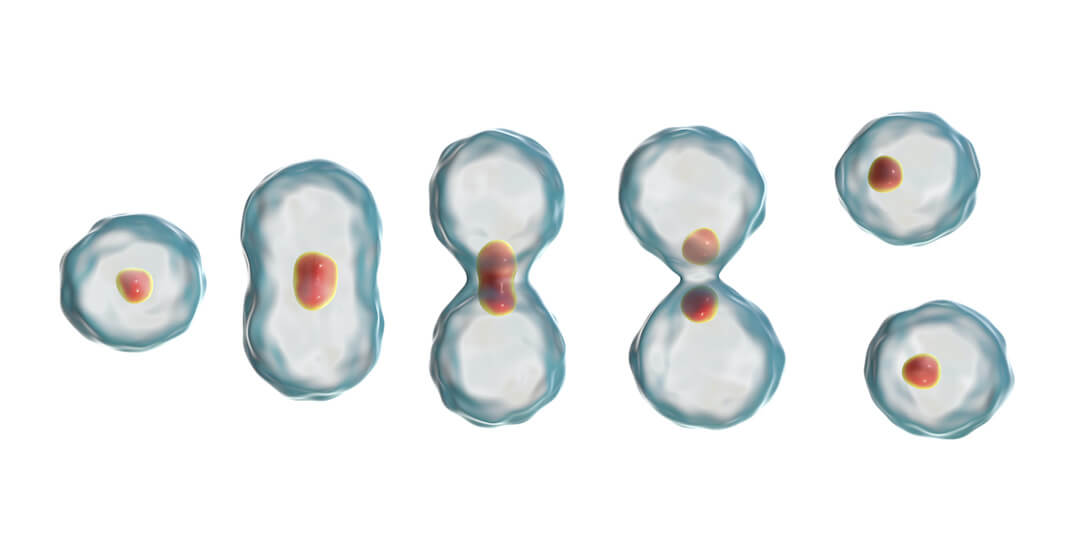
Every cell goes through a growth cycle: it is born, matures, and divides more.
Through each step of the cycle, there are mechanisms to check if the cell is healthy and normal.
When a cell gets worn out, becomes damaged, or is somehow detected as dangerous to its neighbors—it dies.
Basically, it is told to commit suicide—and it happens all the time at the cell level.
The process of “pre-programmed cell death” is called apoptosis. The cell releases particular proteins to break itself down into its components and soon disappears entirely.
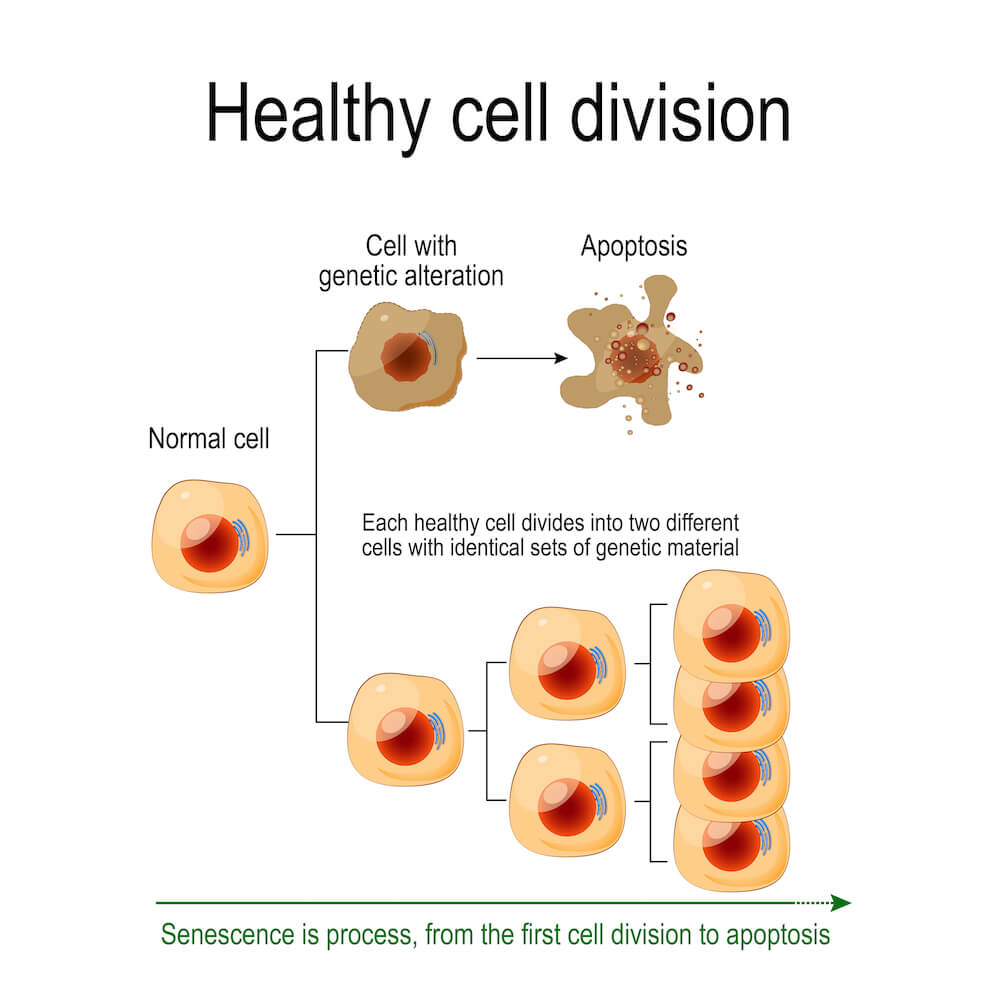
Notice the “pre-programmed” part? Every stage of the growth cycle is determined by genes. And here is where things can get tricky!
Suppose the DNA gets damaged or mutated in the section responsible for regulating the growth cycle. In that case, the cycle itself can go wrong. The cell may start dividing without restraint (causing what doctors call a proliferation of abnormal cells).
The trouble begins when a cell stops answering signals that control cell division and growth.
Ignoring the signals that regulate its growth, a cell may soon become a cancer cell.
The mutations add up: a study shows that a cancer cell can have up to 60 of them in its genes. There are specific genes, a mutation in which is responsible for a particular cancer type. They are called oncogenes.
Probably the most common oncogenes in the cell are growth-promoting Ras genes. They are responsible for receiving signals to grow—a mutation can make the cell’s growth receptors too active.
If we get unlucky, a cell may even start ignoring signals to self-destruct!
With a mutation in a gene responsible for apoptosis, a cell can escape its death! It then divides more, accumulating into a tumor—and those are especially dangerous for the organism.
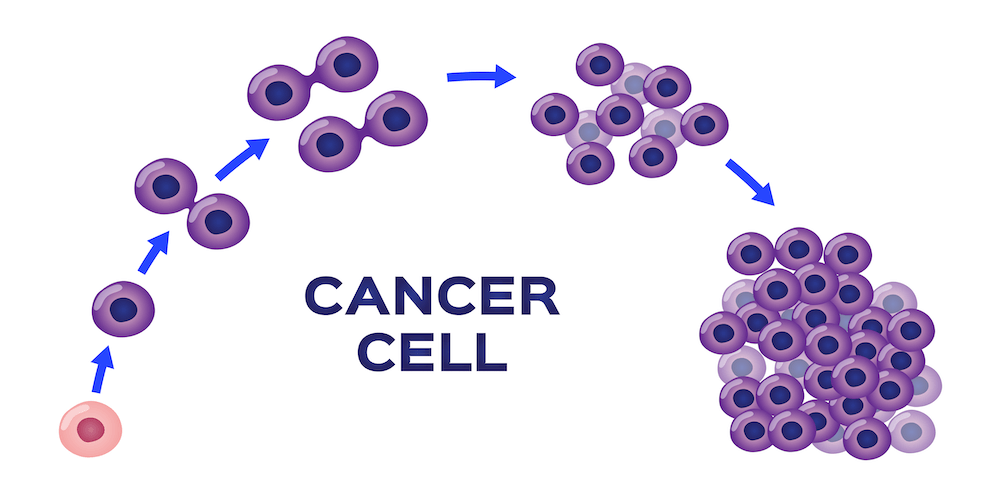
Next up, we’ll look at how to spot them and what makes them so dangerous. Some organs are more likely to develop cancer because they are made of epithelial tissue. Epithelial tissue needs to divide a lot, and each division carries a risk of mutation. Genes regulate cell division and growth; an unlucky mutation can make a cell divide uncontrollably, forming a tumor.
Why tumors are dangerous
A healthy cell does not turn into a cancer cell overnight. A tumor can develop over several years—this process is called oncogenesis.
Early stages
A couple of abnormal cells is no big deal for a human body. However, the tumor continues growing—and eventually becomes big enough to impede the normal functioning of the organs around it. At some point, organs fail, and the patient dies.
It is much easier to remove cancer cells from the body when there’s not a lot of them. Thus, doctors try to detect this dangerous development in the early stages. One of their methods is to analyze tissues for abnormalities—that is, to check for any cells that shouldn’t be there.
After a cell is born, it gets assigned a certain type, which it keeps until the end. But sometimes, an unhealthy cell can change its type, answering a faulty signal or decoding a signal wrongly.
When a mature cell changes its type, it is called metaplasia. It may be an early indication of something very deadly.
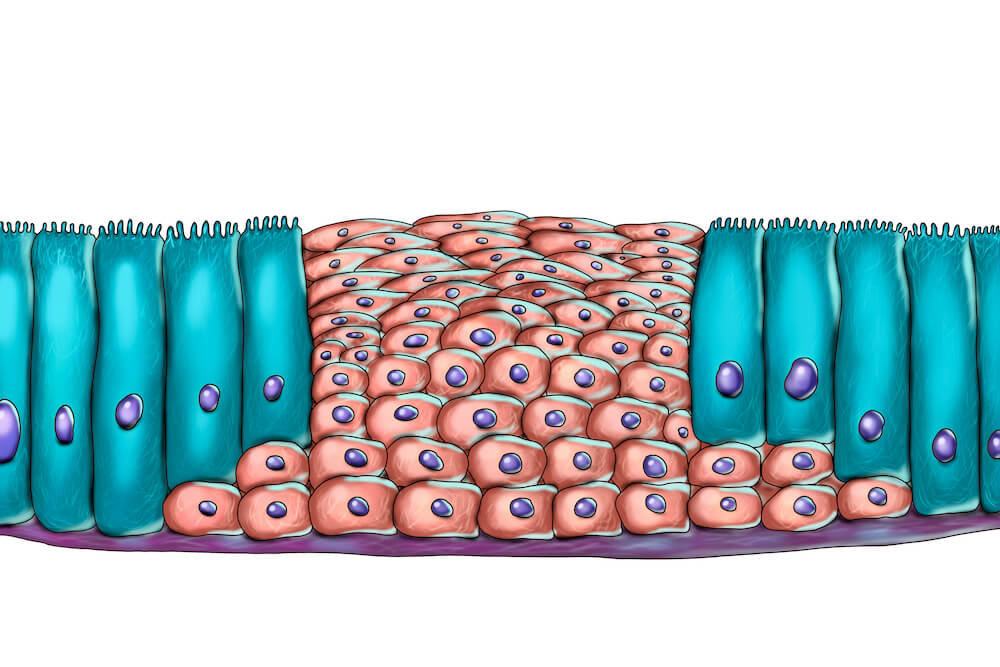
When doctors try to diagnose cancer, they can also find dangerous cells by appearance. A healthy nucleus is always round, but cancer cells have their nuclei irregularly shaped.
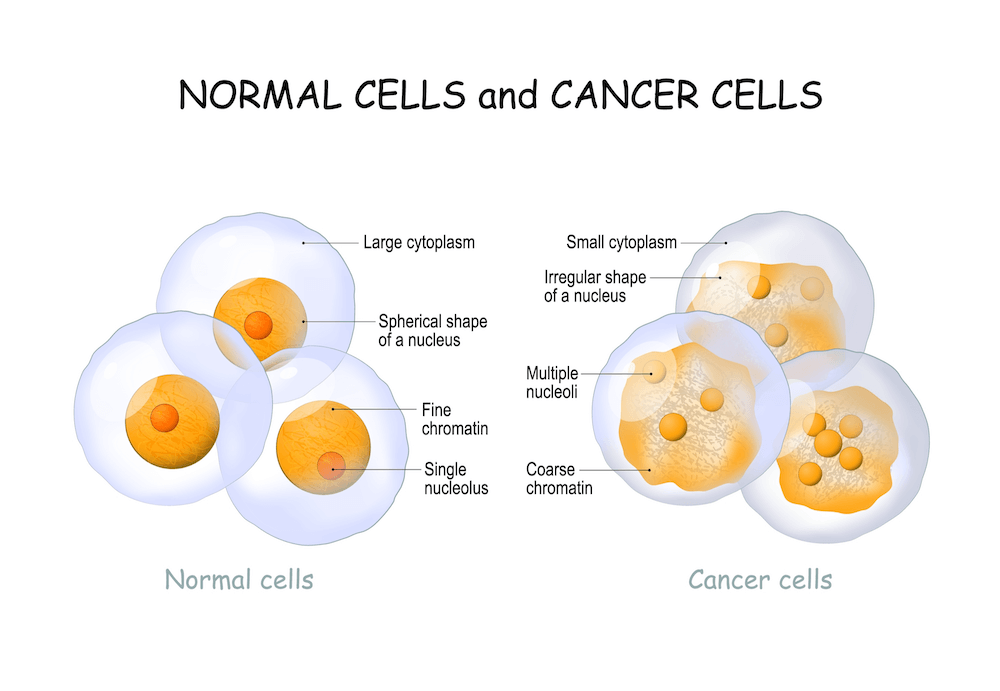
The irregular shape is related to chromatin. Chromatin is a macromolecule that determines how DNA is stored and interacted with. Cancer cells have the normal process of decoding the genes altered, so their chromatin is damaged.
The cells can mostly deal with a tumor on their own: as we’ve learned, there are genes responsible for suppressing. When the cell divides, these genes stay active. In case of a mistake, they either turn on the cell repair mechanism to fix it or activate the apoptosis to kill the cell.
But if a mutation creeps up on those genes as well, there is nothing to stop the abnormal cell division. When the genes fail to prevent mutations, oncogenesis starts—the tumor begins to grow.
Some things make cancer especially dangerous—like the “superpowers” of a movie villain. One of them is avoiding detection: some cells can turn into cancer stem cells to pretend they are not a part of a tumor.

It makes them virtually invisible to the immune system, as well as many drugs and types of treatment.
Later stages
A tumor is likely to pick up more and more mutations, especially those which help it survive and become larger. This ability to build up mutations that shut down repair mechanisms and resist treatment is another “superpower” to add to the list. But it can get even worse than that.
A recent study has found out that cancer cells can develop drug resistance after being treated with those drugs—just like bacteria do.
Metastasis is when cancer cells migrate from their original tumor to new places through the bloodstream and other avenues within the body. When doctors find tumors in many places, it means that metastasis has already started.
And this is very bad—because it is virtually impossible to find and remove tumors from many places at once. Breast cancer, for example, can migrate into bones and lungs, becoming much more deadly. One possibility for research to make cancer less dangerous is to develop a drug that would stop the migration of cancer cells. Many scientific groups are working on that.
That’s even not the full extent of cancer cells’ “superpowers”: like any other villain, they are literally immortal. Telomerase is an enzyme that extends the ends of the DNA molecule (telomeres) and prevents its shortening.

DNA shortening is one of the ways we (and cells inside us) age and die. A cancer cell has a lot of telomerase, making it immortal—and as cancer cells don’t die, the tumor can only grow.

